八年级下册形容词副词的比较级和最高级
100个七八年级形容词副词的比较级和最高级
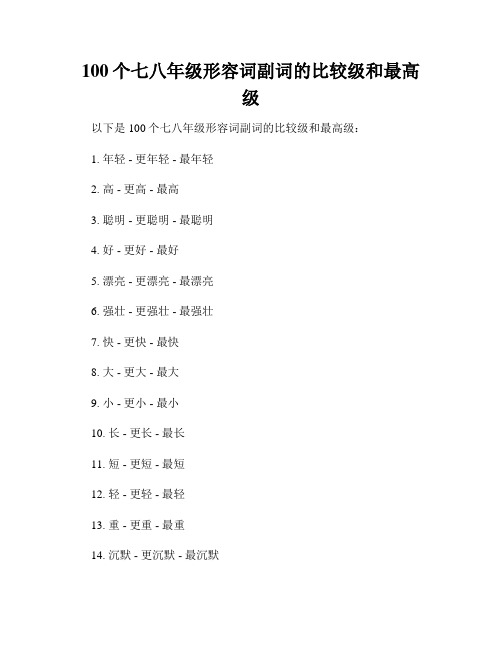
100个七八年级形容词副词的比较级和最高
级
以下是100个七八年级形容词副词的比较级和最高级:
1. 年轻 - 更年轻 - 最年轻
2. 高 - 更高 - 最高
3. 聪明 - 更聪明 - 最聪明
4. 好 - 更好 - 最好
5. 漂亮 - 更漂亮 - 最漂亮
6. 强壮 - 更强壮 - 最强壮
7. 快 - 更快 - 最快
8. 大 - 更大 - 最大
9. 小 - 更小 - 最小
10. 长 - 更长 - 最长
11. 短 - 更短 - 最短
12. 轻 - 更轻 - 最轻
13. 重 - 更重 - 最重
14. 沉默 - 更沉默 - 最沉默
15. 明亮 - 更明亮 - 最明亮
16. 老 - 更老 - 最老
17. 干净 - 更干净 - 最干净
18. 脏 - 更脏 - 最脏
19. 安静 - 更安静 - 最安静
20. 喧闹 - 更喧闹 - 最喧闹
21. 繁忙 - 更繁忙 - 最繁忙
22. 真实 - 更真实 - 最真实
23. 可爱 - 更可爱 - 最可爱
24. 难 - 更难 - 最难
25. 容易 - 更容易 - 最容易
26. 忙碌 - 更忙碌 - 最忙碌
27. 宽 - 更宽 - 最宽
28. 窄 - 更窄 - 最窄
29. 美丽 - 更美丽 - 最美丽
30. 简单 - 更简单 - 最简单
31. 复杂 - 更复杂 - 最复杂
32. 糟糕 - 更糟糕 - 最糟糕
33. 热 - 更热 - 最热
34. 冷 - 更冷 - 最冷
35. 昂贵 - 更昂贵 - 最昂贵
36. 便宜 - 更便宜 - 最便宜
37. 深 - 更深 - 最深
八年级英语下册Unit7语法比较级和最高级讲解

A. in Guangzhou B. Guangzhou
C. that in Guangzhou D. that from Guangzhou
9. Tom is ____ of the two boys.
A. taller B. tallest C. the taller D. the tallest
2. Which goes ___m_o_r_e__sl_o_w_l_y__ (slowly), Tom or Jim?
3.Which book is ___m_o_r_e__in_t_e_r_e_st_i_n_g______ (interesting) ,this one or that one ?
more
most
farther
farthest
◆形容词和副词比较等级的基本句型
as+原级+as “和……一样”
not+as/so+原级+as “不如……”
less+原级+than “不如……”
...比较级 +than... ...比...(更)... (基本句型)
Flat A is more expensive than Flat B. (同义句) Flat B is _l_e_ss__ _e_x_p_e_n_s_iv_e__ than Flat A. Flat B is _c_h_e_a_p_e_r_ _t_h_a_n___ Flat A. Flat B is not _a_s__ _e_x_p_e_n_s_iv_e__ _a_s_ Flat A.
英语人教版八年级下册形容词和副词比较级和最高级
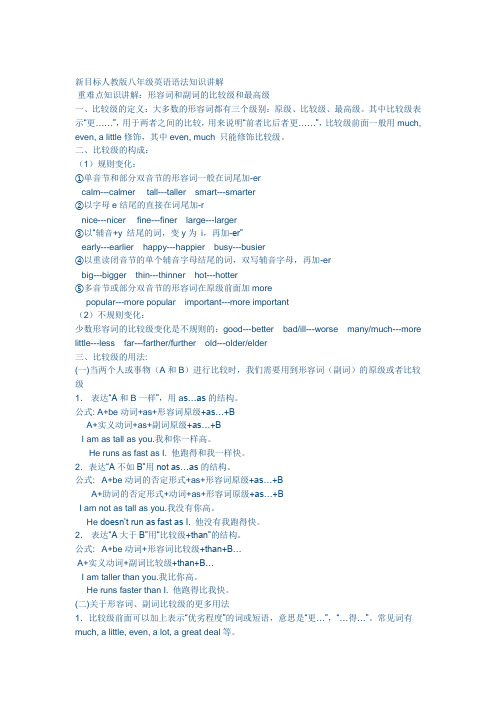
新目标人教版八年级英语语法知识讲解
重难点知识讲解:形容词和副词的比较级和最高级
一、比较级的定义:大多数的形容词都有三个级别:原级、比较级、最高级。其中比较级表示“更……”,用于两者之间的比较,用来说明“前者比后者更……”,比较级前面一般用much, even, a little修饰,其中even, much 只能修饰比较级。
二、比较级的构成:
(1)规则变化:
①单音节和部分双音节的形容词一般在词尾加-er
calm---calmer tall---taller smart---smarter
②以字母e结尾的直接在词尾加-r
nice---nicer fine---finer large---larger
③以“辅音+y 结尾的词,变y为i,再加-er”
early---earlier happy---happier busy---busier
④以重读闭音节的单个辅音字母结尾的词,双写辅音字母,再加-er
big---bigger thin---thinner hot---hotter
⑤多音节或部分双音节的形容词在原级前面加more
popular---more popular important---more important
(2)不规则变化:
少数形容词的比较级变化是不规则的:good---better bad/ill---worse many/much---more little---less far---farther/further old---older/elder
三、比较级的用法:
(一)当两个人或事物(A和B)进行比较时,我们需要用到形容词(副词)的原级或者比较级
形容词和副词的比较级和最高级
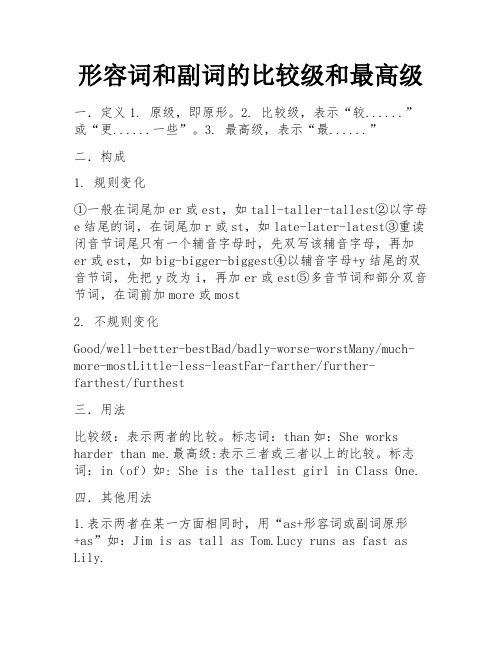
形容词和副词的比较级和最高级
一.定义1. 原级,即原形。2. 比较级,表示“较......”或“更......一些”。3. 最高级,表示“最......”
二.构成
1. 规则变化
①一般在词尾加er或est,如tall-taller-tallest②以字母e结尾的词,在词尾加r或st,如late-later-latest③重读闭音节词尾只有一个辅音字母时,先双写该辅音字母,再加er或est,如big-bigger-biggest④以辅音字母+y结尾的双音节词,先把y改为i,再加er或est⑤多音节词和部分双音节词,在词前加more或most
2. 不规则变化
Good/well-better-bestBad/badly-worse-worstMany/much-more-mostLittle-less-leastFar-farther/further-
farthest/furthest
三.用法
比较级:表示两者的比较。标志词:than如:She works harder than me.最高级:表示三者或三者以上的比较。标志词:in(of)如: She is the tallest girl in Class One.
四.其他用法
1.表示两者在某一方面相同时,用“as+形容词或副词原形
+as”如:Jim is as tall as Tom.Lucy runs as fast as Lily.
2.表示一方在某方面不如另一方时,用“not as/so+形容词或副词原形+as”如:Jim is not as/so smart as Tom.
100个七八年级形容词副词的比较级和最高级
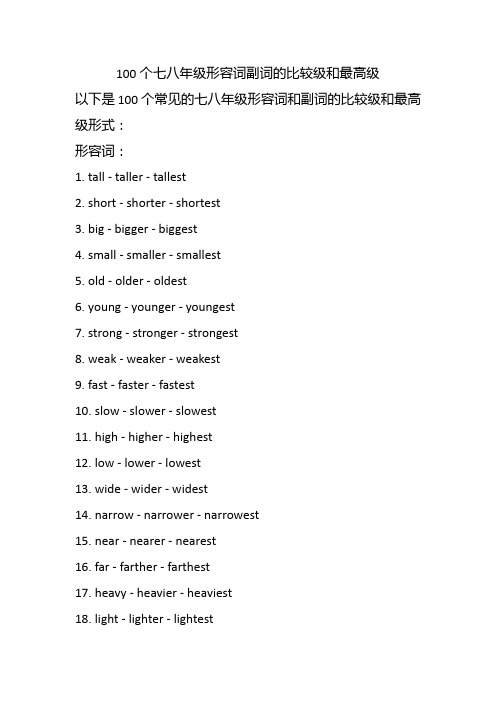
100个七八年级形容词副词的比较级和最高级
以下是100个常见的七八年级形容词和副词的比较级和最高级形式:
形容词:
1. tall - taller - tallest
2. short - shorter - shortest
3. big - bigger - biggest
4. small - smaller - smallest
5. old - older - oldest
6. young - younger - youngest
7. strong - stronger - strongest
8. weak - weaker - weakest
9. fast - faster - fastest
10. slow - slower - slowest
11. high - higher - highest
12. low - lower - lowest
13. wide - wider - widest
14. narrow - narrower - narrowest
15. near - nearer - nearest
16. far - farther - farthest
17. heavy - heavier - heaviest
18. light - lighter - lightest
19. dangerous - more dangerous - most dangerous
20. easy - easier - easiest
21. busy - busier - busiest
形容词和副词的比较级和最高级(完美版)
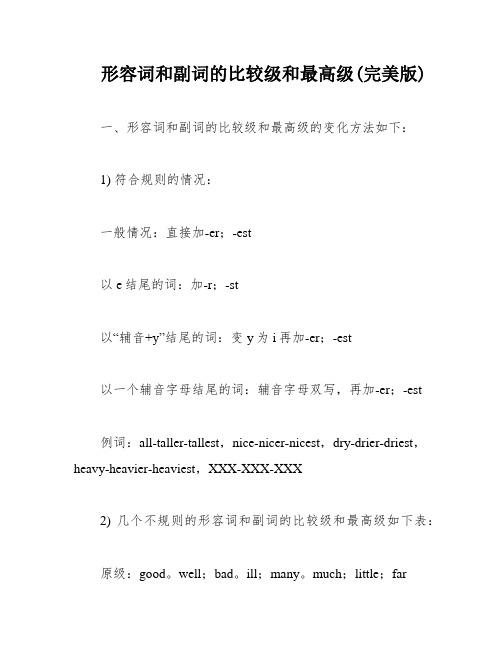
形容词和副词的比较级和最高级(完美版)
一、形容词和副词的比较级和最高级的变化方法如下:
1) 符合规则的情况:
一般情况:直接加-er;-est
以e结尾的词:加-r;-st
以“辅音+y”结尾的词:变y为i再加-er;-est
以一个辅音字母结尾的词:辅音字母双写,再加-er;-est
例词:all-taller-tallest,nice-nicer-nicest,dry-drier-driest,heavy-heavier-heaviest,XXX-XXX-XXX
2) 几个不规则的形容词和副词的比较级和最高级如下表:
原级:good。well;bad。ill;many。much;little;far
二、形容词和副词比较级的用法:
级别比较程度肯定表达方式和意义例句(备注)
原级同等程度 As+原级+as (像……一样) XXX。
not + so (as) +原级+as (不如……那样) English is not so difficult as science。
比较级不同程度 (用于两者比较) 比较级+than (比……) XXX XXX。
比较级前面可以加much。far。even。still。a lot。a little。
a bit等程度加深 I like pork better than beef。
最高级同一范围内的最高程度 The +比较级,the +比较级(越……,越……) XXX gets。the XXX.
The XXX reads。the better their XXX。This is because reading can XXX.
初中英语语法形容词和副词的比较级和最高级
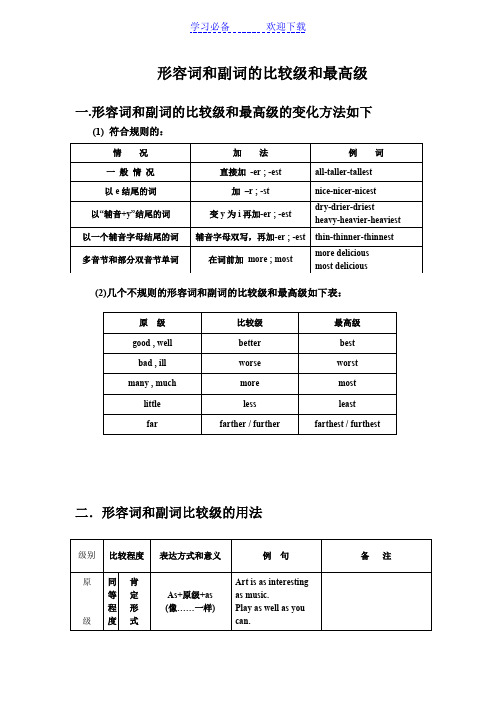
形容词和副词的比较级和最高级
一.形容词和副词的比较级和最高级的变化方法如下
(1) 符合规则的:
(2)几个不规则的形容词和副词的比较级和最高级如下表:
二.形容词和副词比较级的用法
注意:有些形容词,如 dead, empty, round, sure, woolen 等受本身含义的限制,没有比较级。
例题解析
1. He is ________ friends than I.
A. much more
B. many more
C. very more
D. too more
解析:后面有可数名词复数时,many的比较级形式为many more 修饰。应选B.
2. Which is the _________ country, Japan or Australia?
A. more developed
B. more developing
C. most developed
D. most developing
解析:两者比较用比较级,表示"发达"用developed, 而developing 是"发展中的" 意思
3. There were _______ shops in the city in 1982 than in 1990.
A. little
B. few
C. fewer
D. less
解析:little 不能修饰可数名词,两者比较需用比较级,所以应选C.
4. If you are not free today, come another day __________.
A. too
B. so
C. instead
八年级下册形容词和副词的比较级和最高级的用法
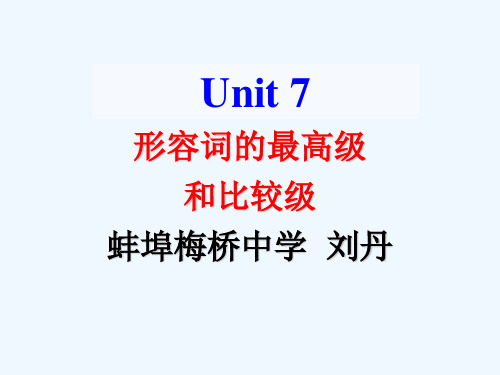
⑥ 越来越...... a. 比较级 + and + 比较级 b. the + 比较级 + 句子,the + 比较级 +
a little, a bit, even, still, much, a lot, far 等可修饰比较级。 e.g. Tom is a little taller than Jim.
This book is much more interesting than that one.
② 同级比较 e.g. The weather in Beijing is colder than that in Xi’an.
many, much — more — most far — farther —farthest (距离远) far — further — furthest (程度深) old — elder — eldest (长幼) old — older —oldest (年龄)
1. 比较级考点 ① 比较级修饰问题
句子
a.e.g. It’s getting colder and colder. The more you exercise, the better
初中语法:形容词及副词的比较级、最高级
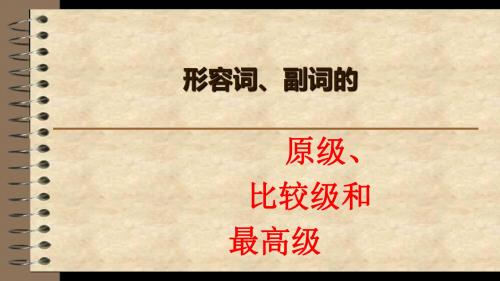
Ⅰ、分类
形容词和副词有原级、比较级和最高级三级。
原级→比较级:1、规则变化 2、不规则变化
Ⅱ、规则变化
1、单音节和部分双音节形容词和副词,在原级的后面加上er、est构成比 较级和最高级。 1) 直接加-er, -est. 如:tall, taller, tallest; great, greater, greatest; strong, stronger, strongest. 2)以不发音的e结尾的单音节词,只加-r, -st.如:nice, nicer, nicest; late,later,latest. 3) 以一个辅音字母结尾的闭音节单词,要双写结尾的辅音字母,然后 加er, est;如:big, bigger, biggest; hot, hotter, hottest; fat,fatter, fattest. 4)以辅音字母 +y 结尾的双音节词,先把y改为 i ,再加上er, est;如: easy, easier, easiest; busy, busier, busiest; early, earlier, earliest. 2、两个音节或两个以上音节的,在原级前加 more/most.如:important, more important, most important.; happily, more happily, most happily.
形容词副词的比较级和最高级总结
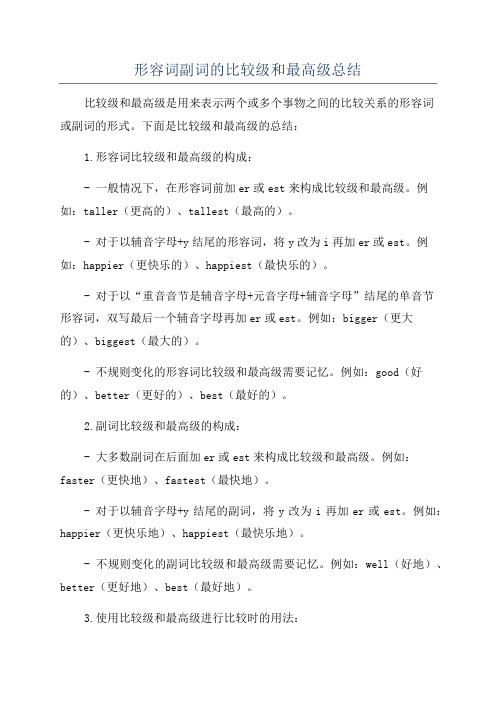
形容词副词的比较级和最高级总结
比较级和最高级是用来表示两个或多个事物之间的比较关系的形容词
或副词的形式。下面是比较级和最高级的总结:
1.形容词比较级和最高级的构成:
- 一般情况下,在形容词前加er或est来构成比较级和最高级。例如:taller(更高的)、tallest(最高的)。
- 对于以辅音字母+y结尾的形容词,将y改为i再加er或est。例如:happier(更快乐的)、happiest(最快乐的)。
- 对于以“重音音节是辅音字母+元音字母+辅音字母”结尾的单音节
形容词,双写最后一个辅音字母再加er或est。例如:bigger(更大的)、biggest(最大的)。
- 不规则变化的形容词比较级和最高级需要记忆。例如:good(好的)、better(更好的)、best(最好的)。
2.副词比较级和最高级的构成:
- 大多数副词在后面加er或est来构成比较级和最高级。例如:faster(更快地)、fastest(最快地)。
- 对于以辅音字母+y结尾的副词,将y改为i再加er或est。例如:happier(更快乐地)、happiest(最快乐地)。
- 不规则变化的副词比较级和最高级需要记忆。例如:well(好地)、better(更好地)、best(最好地)。
3.使用比较级和最高级进行比较时的用法:
- 比较级用于比较两个事物。例如:She is taller than her sister.(她比她妹妹高。)
- 最高级用于比较三个或三个以上事物。例如:He is the tallest boy in the class.(他是班上最高的男孩。)
人教版丨八年级英语下册unit 7 形容词和副词的比较级和最高级
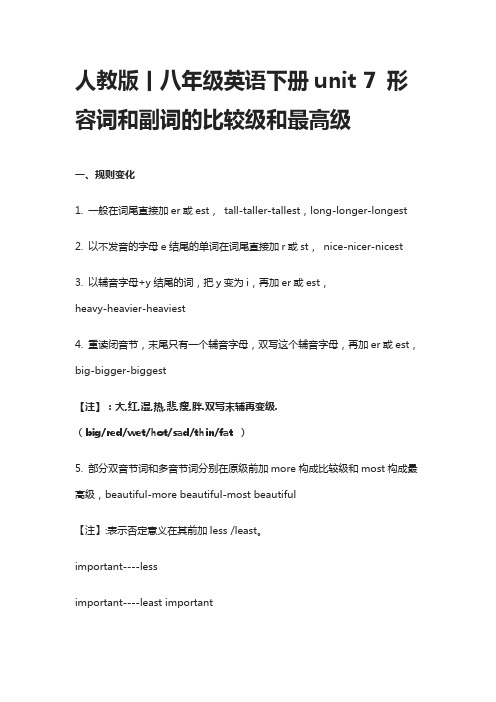
人教版丨八年级英语下册unit 7 形容词和副词的比较级和最高级
一、规则变化
1. 一般在词尾直接加er或est,tall-taller-tallest,long-longer-longest
2. 以不发音的字母e结尾的单词在词尾直接加r或st,nice-nicer-nicest
3. 以辅音字母+y结尾的词,把y变为i,再加er或est,
heavy-heavier-heaviest
4. 重读闭音节,末尾只有一个辅音字母,双写这个辅音字母,再加er或est,big-bigger-biggest
【注】:大,红,湿,热,悲,瘦,胖.双写末辅再变级.
(big/red/wet/hot/sad/thin/fat )
5. 部分双音节词和多音节词分别在原级前加more构成比较级和most构成最高级,beautiful-more beautiful-most beautiful
【注】:表示否定意义在其前加less /least。
important----less
important----least important
English is more interesting than Chinese =Chinese is less interesting than English .
6.由“形容词+ly”构成的副词,在其前加more/ most。
slowly---moreslowly----most slowly;但early—earlier---earliest
二、不规则变化
原级→比较级→最高级
good/well→better→best
初中英语形容词和副词的比较级和最高级
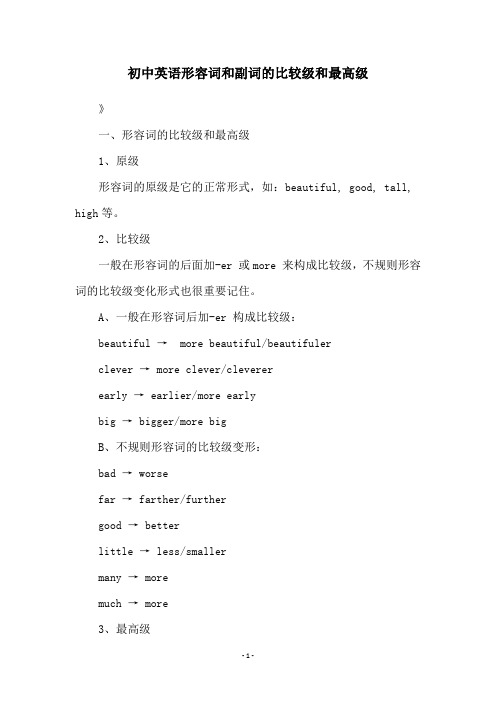
初中英语形容词和副词的比较级和最高级》
一、形容词的比较级和最高级
1、原级
形容词的原级是它的正常形式,如:beautiful, good, tall, high等。
2、比较级
一般在形容词的后面加-er 或more 来构成比较级,不规则形容词的比较级变化形式也很重要记住。
A、一般在形容词后加-er 构成比较级:
beautiful → more beautiful/beautifuler
clever → more clever/cleverer
early → earlier/more early
big → bigger/more big
B、不规则形容词的比较级变形:
bad → worse
far → farther/further
good → better
little → less/smaller
many → more
much → more
3、最高级
一般在形容词前面加the most 或者最高级的词本身来构成最高级。
A、在某些形容词前加the most来构成最高级:
beautiful → the most beautiful
clever → the most clever
early → the earliest
big → the biggest
B、不规则形容词的最高级变形:
bad → the worst
far → the farthest/the furthest
good → the best
little → the least/the smallest
many → the most
much → the most
英语人教版八年级下册Unit7 Grammar focus
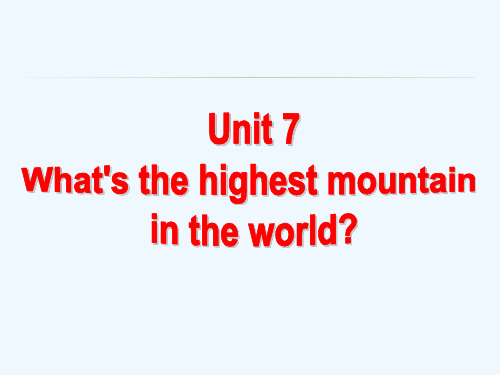
3. 序数词修饰最高级 Mike is the second tallest student in our class. 4.one of + 形容词最高级 +名词复数表示“最… 之一”
b. 以-e 结尾的,比较级+ -r,最高级+ -st。如: large—larger—largest cute—cuter—cutest c. 以辅音字母+y结尾的,变y为i +er或+est。 nice—nicer—nicest
busy—busier—busiest
heavy—heavier—heaviest easy—easier—easiest happy—happier—happiest dirty—dirtier—dirtiest
one of the greatest inventors 4. Edison was_________________________ in the world. (最伟大的发明家之一)
二、同义句转换
1. Flat A is more expensive than Flat B
Flat B is _____ less __________ expensive than Flat A.
初中形容词与副词的比较级最高级
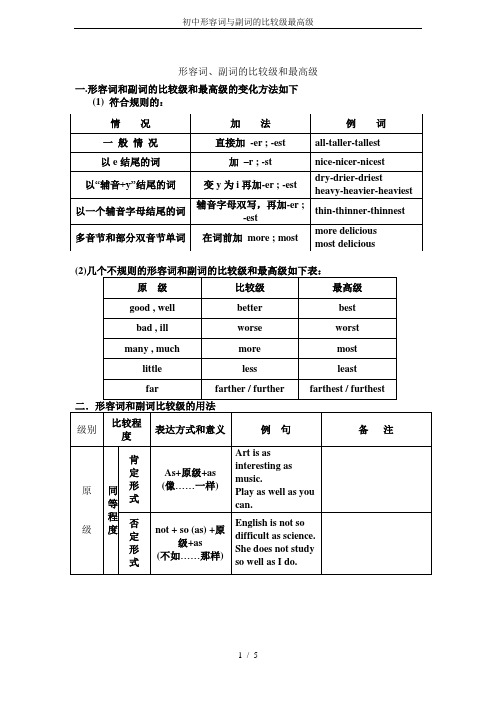
形容词、副词的比较级和最高级
一.形容词和副词的比较级和最高级的变化方法如下
(1) 符合规则的:
(2)
注意:有些形容词,如 dead, empty, round, sure, woolen 等受本身含义的限制,没有比较级。
三.形容词副词比较级最高级的其他用法
(1)和冠词连用
the +形容词原级+v(复),指一类人或物
the +形容词比较级,指两者中“较…的”的那一个,eg. the younger of the two
a/ an +形容词比较级eg. The pen is expensive. I want a cheaper one.
( a) +most+形容词最高级“非常…”eg. a most beautiful city ( 2 ) 相关结构
1)原级比较:肯定句as….as…., 否定句not so / as….as…..
2)比较句:比较级+than….或more (less) ….than…..
The furniture in this shop is less beautiful than that in that shop.(注意代词that的用法)
3)比较级+and+比较级或more and more+比较级“越来越… ”
richer and richer, more and more interesting
4)The more….., the more…..“越…,越…”
The more you look at the picture, the better you will like it.
形容词、副词的比较级和最高级
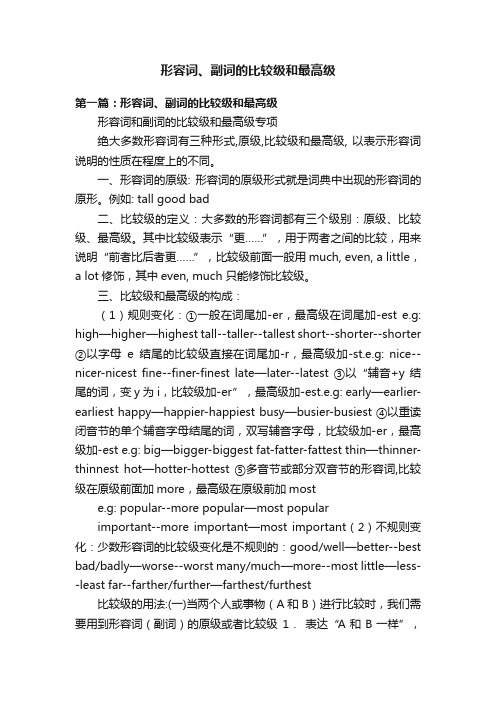
形容词、副词的比较级和最高级
第一篇:形容词、副词的比较级和最高级
形容词和副词的比较级和最高级专项
绝大多数形容词有三种形式,原级,比较级和最高级, 以表示形容词说明的性质在程度上的不同。
一、形容词的原级: 形容词的原级形式就是词典中出现的形容词的原形。例如: tall good bad
二、比较级的定义:大多数的形容词都有三个级别:原级、比较级、最高级。其中比较级表示“更……”,用于两者之间的比较,用来说明“前者比后者更……”,比较级前面一般用much, even, a little,
a lot修饰,其中even, much 只能修饰比较级。
三、比较级和最高级的构成:
(1)规则变化:①一般在词尾加-er,最高级在词尾加-est e.g: high—higher—highest tall--taller--tallest short--shorter--shorter ②以字母e结尾的比较级直接在词尾加-r,最高级加-st.e.g: nice--nicer-nicest fine--finer-finest late—later--latest ③以“辅音+y 结尾的词,变y为 i,比较级加-er”,最高级加-est.e.g: early—earlier-earliest happy—happier-happiest busy—busier-busiest ④以重读闭音节的单个辅音字母结尾的词,双写辅音字母,比较级加-er,最高级加-est e.g: big—bigger-biggest fat-fatter-fattest thin—thinner-thinnest hot—hotter-hottest ⑤多音节或部分双音节的形容词,比较级在原级前面加more,最高级在原级前加most
- 1、下载文档前请自行甄别文档内容的完整性,平台不提供额外的编辑、内容补充、找答案等附加服务。
- 2、"仅部分预览"的文档,不可在线预览部分如存在完整性等问题,可反馈申请退款(可完整预览的文档不适用该条件!)。
- 3、如文档侵犯您的权益,请联系客服反馈,我们会尽快为您处理(人工客服工作时间:9:00-18:30)。
形容词副词专题复习
教
学
设
计
太和县洪山镇中心学校:高波
2017.5
中考英语语法精讲:形容词和副词【教学目标】
掌握形容词和副词的位置,基本用法和比较等级
【教学内容】
I. 形容词:表示人和事物的特征,对名词起修饰和描绘作用
(1)形容词的位置:
1.形容词在句中作定语、表语、宾语补足语等,作定语时一般放在名词前。eg. She has short hair.(作定语)
Paul is tall.(作表语)
We must keep our room clean.(作宾补)
2.形容词修饰不定代词时放在其后。
eg.She has something important to tell us.
There’s nothing wrong in the sentence.
(2)形容词作定语通常前置,但在有些情况下后置,如下表:
(3)多个形容词修饰同一个名词的顺序:
(4)有关形容词的重要考点:
(一)形容词修饰something, anything, nothing, 或由some, any, no构成的不定代词时,把形容词后置。
1. ---Mum, Bill is coming to dinner this evening. ---OK, Let’s give him______ to eat.
A. something different
B. different anything
C. anything different
D. different something
2. ---Will you please tell me_____ in your city?---With pleasure. I think Wu Quan Park is worth visiting.
A. interesting somewhere
B. somewhere interesting
C. anywhere interesting
D. interesting anywhere
(二)形容词作表语,放在系动词be, look, taste, smell, sound, get, become, turn, keep, seem后作表语。
注意:taste, smell, sound+good.
1. ---John looks so_______today because she got an “A” in her maths test.
A. happy
B. happily
C. angry
D. angrily
2. Don’t eat the food. It smells_______. A. badly B. bad C. good D. well
3. ---I’m afraid that I have a bad cold. ---Take the medicine and you’ll feel_______.
A. health
B. best
C. good
D. better
4. The pears taste______and sell______ .
A. well, good
B. well, well
C. good, well
D. good, good
(三)形容词作keep, make, leave的宾语补足语。
1. Tom, you must keep your room_______ .
A. to tidy
B. tidying
C. tidy
2. We should keep our eyes________ while doing eye exercise
A. close
B. closed
C. open
D. opened
(四)exciting, interesting, surprising, amazing, ---ing修饰物
excited, interested, surprised, amazed, ---ed修饰人
1. Oct 15th was one of________ days in 2003. The Shen zhou-V was sent up successfully.
A. exciting
B. more exciting
C. the most exciting
D. much exciting
2. Harry Potter is an_______book for children, but my cousin doesn’t seem at all______in it.
A. interesting, interesting
B. interesting, interested
C. interested, interesting
(五)形、副的比较级前可加much多;a little一点;a lot多;a bit一点;even甚至,更加;far 多;等起修饰作用。
1. The experiment was_______easier than we had expected.
A. more
B. much more
C. much
D. more much
2. The air in Beijing is getting much_______now than a few years ago.
A. clean
B. cleaner
C. cleanest
D. the cleanest
3. This year our school is________ than it was last year.
A. much more beautiful
B. much beautiful
C. the most beautiful
D. beautiful
(六)形容词“越来越”的表达:
a. 单音节词:warmer and warmer, colder and colder.
b. 多音节词前加more and more buantiful, more and more difficult
c. the+比较级+句子.
1. Beijing is becoming______ and________.
A. more beautiful, more
B. beautiful, beautiful
C. more, more beautiful
D. more beautiful, more beautiful
2. Remember boys and girls. _______you work,_______ result you will get.
